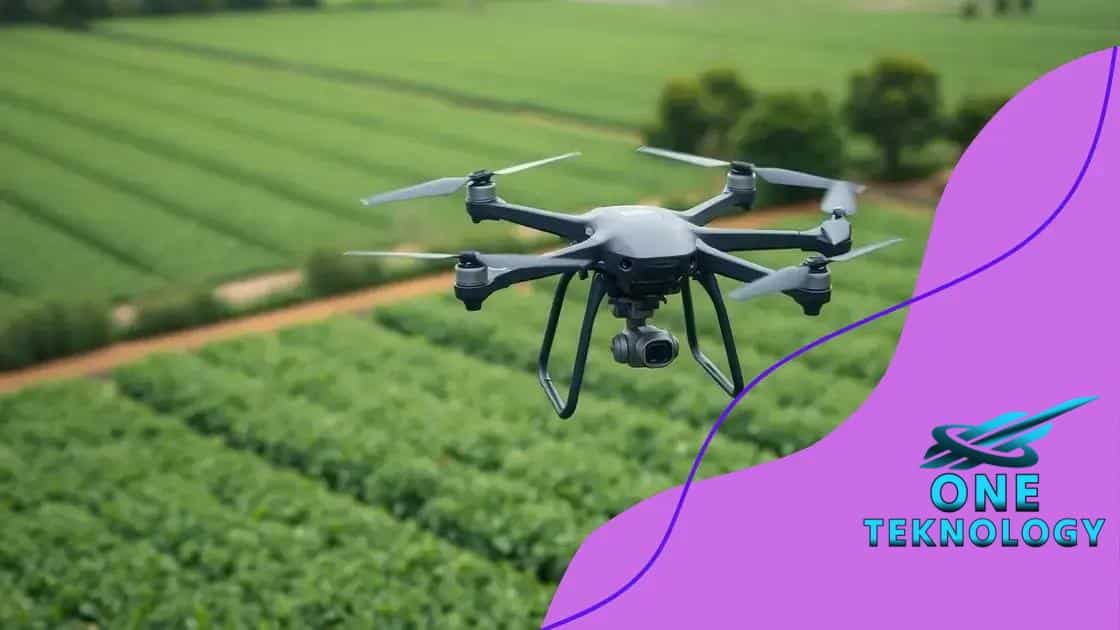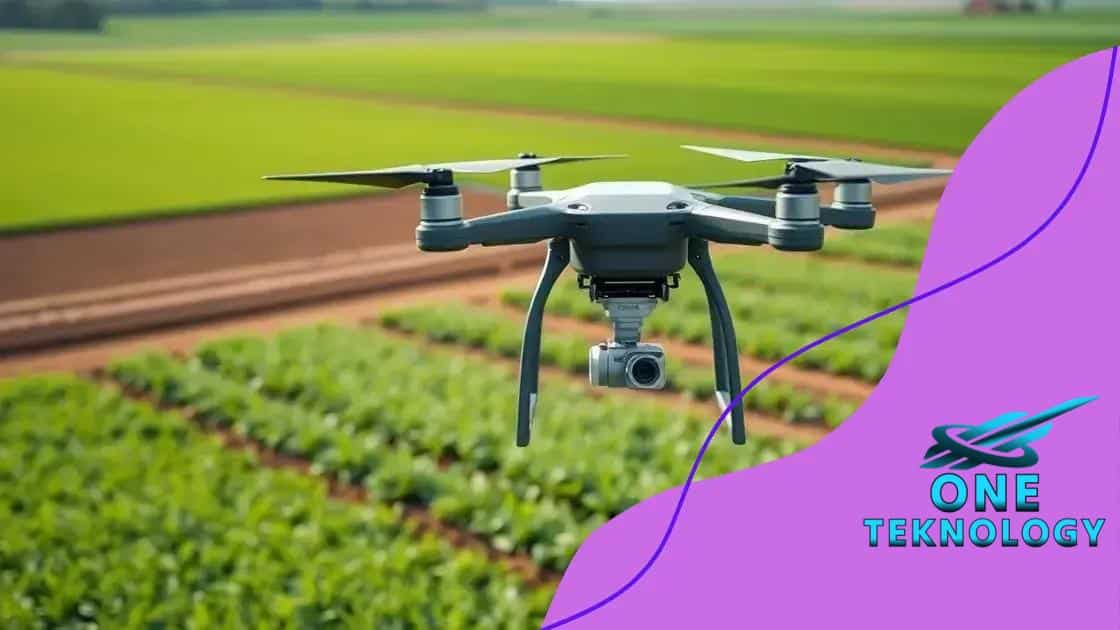How drones are transforming agriculture and farming practices

Drones are transforming agriculture by enhancing crop monitoring, improving resource management, and increasing productivity through advanced data collection and analysis, ultimately leading to more sustainable farming practices.
How drones are transforming agriculture is a game-changer for farmers looking to optimize their practices. Have you ever wondered how aerial technology can make farming more efficient? In this article, we’ll delve into the exciting ways drones are reshaping the industry.
Overview of drone technology in agriculture
Overview of drone technology in agriculture reveals how these devices are changing the farming landscape. Drones are no longer a novelty; they have become essential tools that agriculture professionals use to monitor crops, assess land, and manage resources efficiently.
Understanding the core technology behind drones is vital. They utilize high-resolution cameras, GPS technology, and data analysis tools. These features allow farmers to gain insights into their fields like never before. For instance, drones can capture images of crops to identify health issues early.
Benefits of Drone Technology
The integration of drones in farming provides various advantages. It enhances efficiency, reduces labor costs, and improves crop quality. By automating many processes, farmers can focus on decision-making.
- Precision monitoring of crop health
- Efficient irrigation management
- Soil analysis and mapping
- Fast data collection and analysis
Moreover, the ability to survey large fields in a short time contributes to better resource management. Drones collect data quickly, allowing for timely interventions when problems arise.
Data Collection and Analysis
Using drones, farmers collect data about their fields consistently. This data can be analyzed to provide valuable insights that drive agricultural practices. From identifying pest infestations to assessing water availability, this technology helps in making informed decisions.
As drones evolve, they will continue to play a crucial role in modern agriculture. The combination of hardware and advanced software allows for real-time insights that traditional methods can’t match. Thus, embracing drone technology is essential for farmers aiming to remain competitive in today’s agricultural market.
Benefits of using drones in farming
The benefits of using drones in farming are significant and far-reaching. Farmers are discovering how drones can enhance productivity, save time, and reduce costs. This technology is proving to be a game-changer in modern agriculture.
One of the primary advantages is efficiency. Drones allow farmers to conduct aerial surveys of their crops quickly. This means farmers can gather information on crop health, soil conditions, and irrigation needs in a fraction of the time it would take using traditional methods.
Cost-Effectiveness
Utilizing drones leads to substantial cost savings. By enabling more precise applications of water, fertilizers, and pesticides, farmers can minimize waste and increase their yield. Effective resource management translates to higher profits and sustainability.
- Reduces excess chemical usage
- Minimizes labor costs
- Optimizes resource allocation
- Enhances yield and quality of crops
Moreover, drones help in monitoring livestock health. Farmers can check on their animals and assess their conditions without needing to physically be present, saving both time and efforts.
Data-Driven Decisions
With drones, farmers can make data-driven decisions. The data collected through aerial imagery provides insights that aid in better planning and management. For example, identifying areas affected by pests early leads to timely interventions.
This approach not only improves productivity but also enhances the quality of produce. As farmers embrace these advancements, they position themselves more competitively in the agricultural market.
Real-world applications of drones

The real-world applications of drones in agriculture are vast and impactful. Farmers are using drones for various tasks that enhance their productivity and efficiency. These flying devices are becoming integral to modern farming practices.
One significant application is crop surveillance. Drones are equipped with high-resolution cameras that capture detailed images of fields. This technology allows farmers to monitor crop health, identify diseases, and assess growth patterns efficiently. Timely data can lead to better yields.
Precision Agriculture
Drones play a vital role in precision agriculture. They help farmers apply the right resources at the right time and place. By analyzing the data collected via drones, farmers can determine where specific inputs are needed, reducing waste.
- Targeted spraying of fertilizers and pesticides
- Identifying irrigation issues
- Mapping soil health and variability
- Monitoring livestock locations and health
Another application is in field mapping. Drones create detailed maps that can be used for planning and management. These maps provide insights into field boundaries, slopes, and soil types. This information is crucial for making informed decisions.
Disaster Management
Drones are also used for disaster management in agriculture. After natural disasters like floods or wildfires, drones can quickly assess the damage. Farmers can use the data to strategize recovery efforts effectively.
By utilizing drones for various applications, farmers can not only increase their efficiency but also decrease their labor costs. As technology advances, the capabilities of drones will continue to expand, providing even more solutions for agricultural challenges.
Challenges faced by farmers using drones
Despite the numerous advantages, there are also significant challenges faced by farmers using drones. Understanding these challenges helps farmers navigate the complexities of integrating drone technology into their agricultural practices.
One major issue is regulatory compliance. Many regions have strict laws governing drone use. Farmers must ensure they are operating within legal boundaries, which can sometimes be confusing.
Costs of Technology
Another challenge is the initial cost of purchasing drones. Although drone technology can save money in the long run, the upfront investment can be substantial. Farmers need to evaluate their budgets carefully before making purchasing decisions.
- Initial buying costs of drones
- Maintenance and repair expenses
- Training for effective use
- Upgrading software and technology
Training is essential for effective drone usage. Farmers may need to invest time and resources into learning how to operate drones efficiently. Understanding how to analyze the data collected is equally important; without the right skills, the benefits of drone technology may not be fully realized.
Technical Issues
Technical problems can also arise. Drones can face issues like connectivity problems or software malfunctions. These disruptions can lead to frustration and downtime. Furthermore, ensuring software is up-to-date is crucial for optimal performance.
Weather conditions can also impact drone operations. Factors like strong winds or heavy rain can hinder the ability to fly drones safely and accurately. Farmers need to consider environmental factors when planning their drone activities.
The future of drones in agriculture
The future of drones in agriculture looks promising as technology continues to advance. Farmers are already seeing the benefits of incorporating drones into their practices, and their role is expected to grow significantly over the coming years.
One of the key trends is the increased use of artificial intelligence in drone technology. AI can help analyze data more effectively, allowing for real-time decision-making. This will enhance precision farming, ensuring that resources are used efficiently and sustainably.
Integration with Other Technologies
Drones will likely integrate better with other agricultural technologies, such as sensors and Internet of Things (IoT) devices. This synergy can provide comprehensive insights into crop health and soil conditions. With this data, farmers can make more informed choices and further optimize their yields.
- Enhanced crop management
- Improved livestock monitoring
- Automated processes for data collection
- Better resource allocation
As drones become more affordable, even smaller farms will be able to adopt this technology. This democratization of drone usage could lead to a massive shift in agricultural practices worldwide. Smaller farmers will benefit from the same advancements as larger operations.
Environmental Benefits
The future also holds promises for environmental sustainability. Drones can help reduce chemical usage by allowing farmers to apply fertilizers and pesticides more accurately. This lowers the risk of runoff and chemical pollution, promoting healthier ecosystems.
As regulations become clearer and drone technology continues to improve, we can expect farms to become smarter, more efficient, and more productive. The evolution of drones in agriculture will be essential for meeting the growing demands of food production while ensuring environmental protection.
FAQ – Frequently Asked Questions about Drones in Agriculture
How do drones improve crop monitoring?
Drones provide high-resolution images and data that help farmers assess crop health and identify potential issues early.
What are the regulations around using drones in agriculture?
Regulations vary by location, but farmers must comply with local laws governing drone operations, including flight altitude and no-fly zones.
Can drones help with livestock management?
Yes, drones can monitor livestock locations and health, making it easier for farmers to manage their herds.
What are the cost implications of using drones?
While initial costs can be high, drones can ultimately reduce labor costs and increase efficiency, leading to long-term savings.






